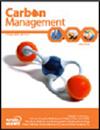在水有限的环境中,每滴更多的碳可以增强土壤的固碳能力
IF 3.2
4区 环境科学与生态学
Q3 ENVIRONMENTAL SCIENCES
引用次数: 0
摘要
土壤通过储存碳(C),为气候变化提供了自然解决方案。然而,大规模实施碳固存做法是复杂的,因为固存率因气候条件、土壤类型和农业管理而异。研究人员面临着在干旱和半干旱地区确定有效碳封存措施的挑战,因为降水限制了植物生物量的生产。我们讨论了“每滴更多的碳”的方法来加强在水资源有限的环境中的碳固存。该方法强调通过提高水分利用效率和土壤储水量来增加土壤有机碳(SOC)的固存和减少温室气体的排放。增加碳投入的数量和多样性、提高作物养分有效性和减少土壤干扰的农业策略可以同时封存土壤碳并增强土壤水分储存。在增加土壤水分储存的同时加强有机碳固存的策略可能有利于干旱和半干旱地区的农民,因为他们可以保持净零或净负碳足迹。因此,实施促进有机碳封存和土壤水分储存的政策可以为世界上面临水资源限制的广大地区提供自然的气候解决方案。在水资源有限的环境中,有机碳的封存是一项挑战;改变碳固存管理实践所带来的社会、经济和文化挑战可以通过一系列不同的激励措施来解决。激励传统的碳固存实践,同时投资研发新的前沿技术,可以提供一个双赢的解决方案本文章由计算机程序翻译,如有差异,请以英文原文为准。
More carbon per drop to enhance soil carbon sequestration in water-limited environments
Abstract By storing carbon (C), soil provide natural solutions to climate change. However, implementing C sequestration practices on a large scale is complex because sequestration rates vary with climatic conditions, soil types and agricultural management. Researchers face challenges identifying effective C sequestration practices in arid and semi-arid regions because precipitation limits plant biomass production. We discuss the “more carbon per drop” approach to enhance C sequestration in a water-limited environment. This approach emphasizes increasing soil organic carbon (SOC) sequestration and reducing greenhouse gas emissions by enhancing water use efficiency and soil water storage. Agricultural strategies that increase the amount and diversity of C inputs, improve nutrient availability for crops, and minimize soil disturbance can simultaneously sequester soil C and enhance soil water storage. Strategies for enhancing SOC sequestration while increasing soil water storage could benefit farmers in arid and semi-arid regions because they can maintain a net-zero or net-negative C footprint. Therefore, implementing policies that promote SOC sequestration and soil water storage could provide natural climate solutions to the vast areas of the world facing water limitations. KEY POLICY HIGHLIGHTS SOC sequestration in a water-limited environment is challenging; more carbon per drop simultaneously increases SOC and soil water storage The social, economic, and cultural challenges of changing management practices for C sequestration could be addressed through a diverse set of incentives Incentivizing conventional SOC sequestration practices while investing in research and development of new frontier technologies could provide a win–win solution
求助全文
通过发布文献求助,成功后即可免费获取论文全文。
去求助
来源期刊

Carbon Management
ENVIRONMENTAL SCIENCES-
CiteScore
5.80
自引率
3.20%
发文量
35
期刊介绍:
Carbon Management is a scholarly peer-reviewed forum for insights from the diverse array of disciplines that enhance our understanding of carbon dioxide and other GHG interactions – from biology, ecology, chemistry and engineering to law, policy, economics and sociology.
The core aim of Carbon Management is it to examine the options and mechanisms for mitigating the causes and impacts of climate change, which includes mechanisms for reducing emissions and enhancing the removal of GHGs from the atmosphere, as well as metrics used to measure performance of options and mechanisms resulting from international treaties, domestic policies, local regulations, environmental markets, technologies, industrial efforts and consumer choices.
One key aim of the journal is to catalyse intellectual debate in an inclusive and scientific manner on the practical work of policy implementation related to the long-term effort of managing our global GHG emissions and impacts. Decisions made in the near future will have profound impacts on the global climate and biosphere. Carbon Management delivers research findings in an accessible format to inform decisions in the fields of research, education, management and environmental policy.
 求助内容:
求助内容: 应助结果提醒方式:
应助结果提醒方式:


